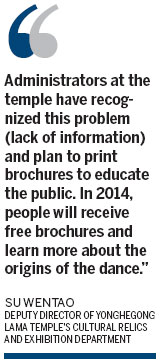Lamas dance with the 'devil' at Beijing temple
Updated: 2013-03-12 07:49
By Li Yao (China Daily)
|
||||||||

Masked lamas performed their annual "devil dance", a ritual believed to ward off disasters and ghosts, on Monday at Yonghegong Lama Temple in Beijing.
The performance, also called Buza Dancing, a term that originates from the Mongolian language and means "beating the devils", is held every year on the 30th day of the first lunar month.
On Tuesday morning, the last day of the ceremony, lamas will circle the temple while carrying a golden statue of Maitreya Buddha, also known as the Laughing Buddha, an embodiment of kindness. A large group of Buddhists will follow behind.
This will mark the climax of an eight-day ceremony that monks observe to pray for peace and prosperity in the coming year.
The devil dance has been held annually since 1987, when it was reinstated after a period of suspension, said Su Wentao, deputy director of the temple's cultural relics and exhibition department.
He said lamas started to prepare for the annual ritual about a month ago. A stage was set up last week, covered with red carpet, and lamas would rehearse after visitors to the temple had left.
"Not all lamas will participate," Su said. "Younger lamas are normally chosen because the dance requires physical strength and stamina."
Three large Thangka - Tibetan scroll paintings - were placed in front of Yonghe Gate Hall, the first hall visitors see after entering the temple's main gate.
At 3 pm, the abbot appeared with his full entourage, all dressed in ritual costumes, from the east side of the hall. Behind the abbot, 12 lamas beat drums and cymbals as the "battle with the devil" took place.
Lamas escorted a skeletonlike figure symbolizing the devil onto the stage. The devil was later carried to the south gate of the temple and thrown into a fire, while Buddhist scriptures were recited.
Then they returned and distributed candies, said to guarantee good fortune, to the crowd.
Wang Shucai, 85, from Qingdao, Shandong province, visited the temple with her family.
Her 6-year-old granddaughter was excited to see the performance, saying she will share the experience with her friends back home.
Many foreigners were among the audience.
Christine Bellemer, a painter from France, watched the performance with her Chinese daughter-in-law.
"I am very curious about this ritual and the performance was really great," Bellemer said.
The temple sees its biggest influx of visitors on the first day of the Lunar New Year, receiving about 100,000 visitors.
But much fewer people came on the "devil dance" day, as the ceremony is not so well known, Su said.
The temple stepped up its security and hired extra guards during the ceremony. Thefts are rare, and the main job of the guards is to maintain order and prevent possible fires.
Vicky Ramos and Clara Bonet, both from Spain, met each other at the temple on Monday. They watched the entire ceremony, but had no idea what it was about, only knowing that it was a very special occasion.
Similar opinions were expressed during a rehearsal on Sunday afternoon. A young woman left about 10 minutes after the dance began, saying that she knew how to perform it after watching it for a while.
"Administrators at the temple have recognized this problem and plan to print brochures to explain this to visitors," said Su, the deputy director. "In 2014, people will receive free brochures and learn more about the origins of the dance."
Ye Qi, a lay Buddhist, has attended the ceremony for several years. Ye said Buddhism liberates her from worries and she is content to live a simple life on a frugal budget.
liyao@chinadaily.com.cn
(China Daily 03/12/2013 page3)

 In Photos: 7.0-magnitude quake hits Sichuan
In Photos: 7.0-magnitude quake hits Sichuan
 Li Na on Time cover, makes influential 100 list
Li Na on Time cover, makes influential 100 list
 FBI releases photos of 2 Boston bombings suspects
FBI releases photos of 2 Boston bombings suspects
 World's wackiest hairstyles
World's wackiest hairstyles
 Sandstorms strike Northwest China
Sandstorms strike Northwest China
 Never-seen photos of Madonna on display
Never-seen photos of Madonna on display
 H7N9 outbreak linked to waterfowl migration
H7N9 outbreak linked to waterfowl migration
 Dozens feared dead in Texas plant blast
Dozens feared dead in Texas plant blast
Most Viewed
Editor's Picks

|

|

|

|

|

|
Today's Top News
Live report: 7.0-magnitude quake hits Sichuan, heavy casualties feared
Boston suspect cornered on boat
Cross-talk artist helps to spread the word
'Green' awareness levels drop in Beijing
Palace Museum spruces up
First couple on Time's list of most influential
H7N9 flu transmission studied
Trading channels 'need to broaden'
US Weekly

|

|







